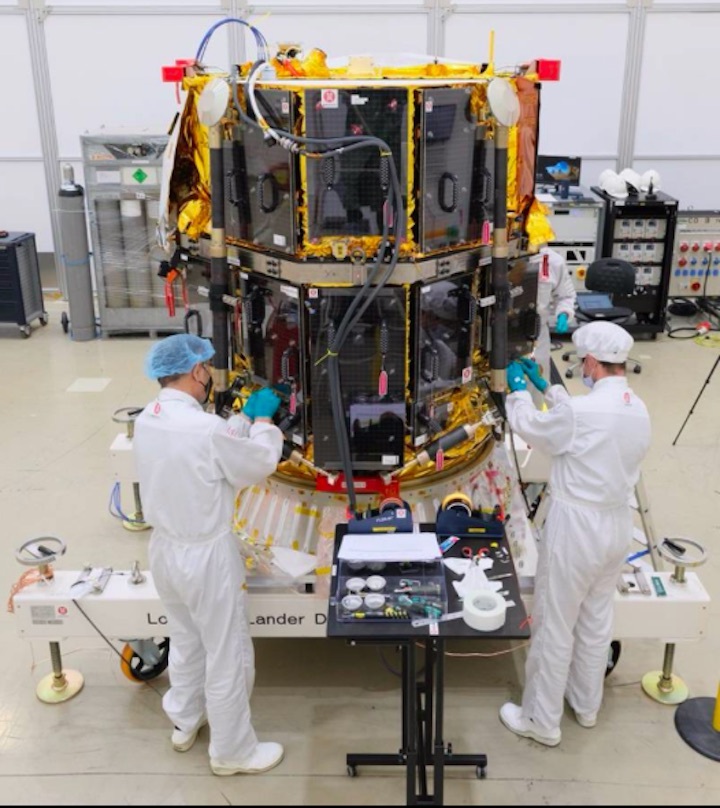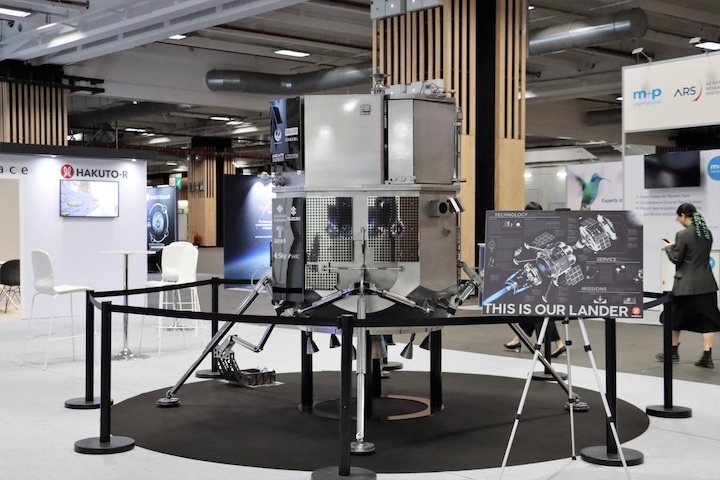18.12.2021
The Arab world's first mission to the Moon is expected to launch in less than a year

The logo will be featured on the Rashid Rover, which is slated for launch in 2022. Courtesy: MBRSC
The UAE’s Mohammed bin Rashid Space Centre is collaborating with local and international universities to carry out its lunar mission’s science goals.
With the launch of the Rashid rover, a small 10-kilogram lunar vehicle, less than one year away, the team is finalising its scientific objectives.
The partners will help develop the main instruments on board the rover, including the Langmuir probe – an instrument that measures plasma – data collection, landing site research, calibration strategies and data analysis.
One of the new partners is New York University Abu Dhabi, which will work on the microscopic camera calibration and investigate the interaction of the rover's surface materials with the solar radiation.
Elon Musk’s SpaceX will carry the mission into space from Florida’s Kennedy Space Centre on a Falcon 9 rocket, then a Japanese private company called iSpace will carry the rover to the lunar surface.
“The partnership with local and international partners demonstrates the possibilities that the Emirates Lunar Mission’s science programme offers academia,” said Salem Al Marri, director general of the space centre.
“Students and early researchers are already participating in the development of this lunar rover project and are contributing to making qualitative developments in the fields of science, communication technologies and robotics.
“Furthermore, the impact of these developments will extend beyond the space sector and into various vital sectors in the UAE and around the world.”
The UAE is launching a mission to the Moon to study the properties of regolith, or lunar soil, and the thermal properties of the surface.
Rashid’s four wheels will have different materials attached to them to see how each interacts with the regolith.

The experiment could help space agencies develop better spacesuits for future astronauts, because lunar soil sticks to almost everything and posed a major challenge during the Apollo missions.
MBRSC has also partnered with France’s Centre for Petrographic and Geochemical Research at Universite de Lorraine to study the conditions of the landing sites and analyse data retrieved from the rover’s microscopic imager.
The imager will take high-resolution photos of the lunar surface, giving scientists a view of the undisturbed, topmost layer of the regolith.
This could provide clues to the evolution and formation of the lunar surface.
Another partnership was formed with the University of Oslo in Norway, where a team is developing the Langmuir probes that will study the plasma around the Moon.
Data from the instrument could help scientists understand how charged particles interact with the lunar surface.
It is believed this interaction lifts dust particles and carries them for certain distances.
MBRSC said an international team of researchers was necessary to meet the demanding requirements for the mission, including the development of the rover and science instruments.
It was previously announced that the French space agency is providing the mission with two optical cameras that are crucial to the project.
Airbus Defence and Space is providing the materials that will be attached to Rashid’s wheels.
Meet the designer of the UAE's lunar mission logo - in pictures

The Emirates Lunar Mission logo as revealed by Sheikh Hamdan bin Mohammed, Crown Prince of Dubai. It features the signature of Sheikh Rashid, the late ruler of Dubai. Courtesy: Sheikh Hamdan bin Mohammed Twitter
Quelle: The National
----
Update: 11.10.2022
.
Rashid rover: Everything you need to know about UAE’s Moon mission
In a first for the Arab world, the 10kg explorer will travel aboard a Japanese lander on a US carrier rocket

The flight model of the Mission 1 Hakuto-R lander by private company ispace inc, which will deliver UAE rover Rashid to the lunar surface later this year. Photo: ispace
The launch of the Emirati-built Rashid rover will help to pave the way for the UAE’s long-term Moon exploration programme.
It is the first lunar spacecraft built by an Arab country and is expected to blast off next month from a spaceport in Florida.
As momentum builds towards this landmark mission, The National looks at what we know about the Rashid rover.
Who built the Rashid rover?
The four-wheel rover, weighing only 10 kilograms, has been built by engineers from the Mohammed bin Rashid Space Centre.
A core team of 11 are behind the mission’s development and have been working on it since 2017.
They hope the rover will land on the Moon’s near side, the one that faces the Earth, to study an unexplored region.
The rover is named in honour of the late Sheikh Rashid Al Saeed, the former Ruler of Dubai and the father of Sheikh Mohammed bin Rashid, Vice President and Ruler of Dubai.
When is it launching?
A final date for take-off has not been announced yet, but The National revealed the launch window last month.
That could be any time between November 9 and 15 from the Space Launch Complex 40 at Cape Canaveral Space Force Station.
How will it travel to the Moon and land on the surface?
The rover is hitching a ride on the Hakuto-R Mission 1 lander, built by Japanese company ispace. This is also ispace's first lunar mission.
A lander is a type of spacecraft that can touch down on a planetary surface. It is equipped with a propulsion and navigation system that allows it to power through space and land safely with its cargo.
Rashid was integrated into the lander last month and together the package was expected to be shipped to the launch site at that time.
A SpaceX Falcon 9 rocket belonging to Tesla founder Elon Musk's company will carry the mission to space.
From there, the lander will make its three-month journey to the Moon, with the rover safely stored inside.

The goal is to land in the Atlas crater in the Mare Frigoris site, located in the far-north of the Moon’s near side.
If it manages to soft-land on the lunar surface, the lander will set Rashid down on a ramp. They will then communicate by wireless, in the same way mission control monitors the spacecraft and its payload on its journey to the Moon and on the surface.
What will Rashid do there?
Mohammed bin Rashid Space Centre says that this is a science mission.
The rover will study the properties of lunar soil, the petrography and geology of the Moon, dust movement, and study surface plasma conditions and the Moon's photoelectron sheath.
Lunar dust, or regolith, is one of the main challenges astronauts face on the Moon.
It was during the Apollo missions that scientists learnt how lunar dust stuck to spacesuits, causing erosion and operational problems.
With space agencies determined to send human beings to the Moon again, razor-sharp lunar dust particles remain a concern as they stick to nearly everything.
The Rashid rover is designed to address this problem with an experiment that will test different materials against the dust.
Called the material adhesive experiment, a variety of test samples would be attached to the rover’s wheels.
In addition, mission control in Dubai is also expecting to receive thousands of images from the rover.
The French space agency has supplied two cameras to the rover. One is placed on top for panoramic images of the robot’s surroundings. The other one is a rear camera that would capture images as the lander throws up regolith behind it.
How long will it ‘stay alive’ for?
The mission will last one lunar day, or 14 Earth days.
The team also hopes the rover can survive the lunar night, also 14 days, when temperatures plunge to -183°C.
Will there be more Moon missions by the UAE?
Yes, the UAE announced a long-term Moon exploration programme that would involve multiple missions.
It is already working on Rashid 2. China will help to launch the rover on its Chang’e-7 lunar south pole mission in 2026.
Quelle: The National
